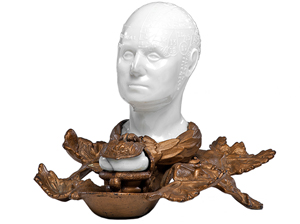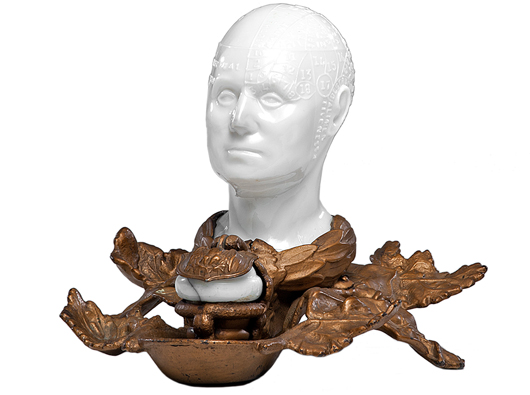
BEACHWOOD, Ohio – Hundreds of reproduction phrenology heads are sold online, although few understand what the word phrenology means. It was not a medical theory or a science, but rather a way to “determine” the character and temperament of a person.
In 1796 a German physician, Franz Joseph Gall, began teaching a discipline he called phrenology – the study of a patient based on the bumps on the patient’s head. Gall said there were 27 different bumps, each caused by the brain mass inside the skull. He called each bump an “organ,” and very soon prints and 3-D ceramic heads covered with “maps” of the brain were produced – all of them collectible today. From about 1810 to 1840, phrenology was widely accepted. From the measurement of the skull and the size of the “organ” inside, Gall claimed to identify character traits. For example, he said that all women had undeveloped organs for success as artists or scientists, but that their other organs indicated they were religious and good at childcare. Bumps also could indicate a criminal nature, risk-taking, combativeness, love of life or self-esteem.
Phrenology eventually was debunked as a pseudoscience and has few followers today. But the heads are popular conversation pieces. Phrenology items recently offered for sale online included an iron inkwell stand topped by a 6-inch-high milk glass head with appropriate marks, six different styles of busts marked with black lines showing the “organs,” and charts old and new. You also can find instruments to measure the bumps, and even a bicycle helmet painted with the names of the bumps.
A bump over the top of the front of the right ear, just about where the sidepiece of your eyeglasses would sit, indicates acquisitiveness, a trait needed by every collector.
Q: I have two chairs that I’d like to sell. Each has a metal plate underneath that reads “Made in England by Jaycee Furniture Ltd., Brighton, Sussex” and another that reads “Made in England expressly for Carson Pirie Scott and Co.” Can you tell me what they’re worth?
A: Jaycee Furniture made reproduction furniture in traditional styles. The company was founded by Jack Cohen in 1947 and closed in 1998. Carson Pirie Scott & Co. was a furniture store headquartered in Chicago. It started when Samuel Carson and John Pirie founded a dry goods store in Amboy, Ill., in 1854. The company moved to Chicago during the late 1860s. It became Carson Pirie Scott & Co. when Robert Scott became a partner in 1890. The company still is in business, now operating under the name Carson’s. The labels on your chairs suggest they were sold after 1950. The chairs would sell as useful pieces of furniture, but not as antiques. The price probably will be less than half the cost of a similar new chair.
Q: I have a couple of vintage issues of a French comic book titled “Les Pieds Nickeles.” Is there a collecting club for this sort of thing?
A: The French comic strip titled Les Pieds Nickeles (loosely translated as The Nickel-Plated Feet Gang) was first published in 1908. The strips must have been collected later for publication as comic books. Several U.S. auctions specialize in selling old comic books, although yours is not well-known here and won’t be high-priced. One club for collectors is the Comic Book Collectors Club (ComicBookCollectorsClub.com).
Q: In 1973, I was working for the post office in Whitewater, Calif. When the post office moved into a trailer, all of its furniture was sold or tossed. I was lucky enough to buy a wooden postal sorting table for $5. It includes a mail-sorting case with 100 small cubbyholes – four rows of 25. The table is 70 inches long by 26 inches deep. Including the case, it’s 64 inches high. The case is stamped on the back: “516-B Carriers Routing Case & Table, Property of the Post Office Dept., from Corbin Cab’t. Lock Co., New Britain, Conn., 1929.” We consider it a family heirloom, but would like to know what you think of it.
A: Corbin Cabinet Lock Co. was founded in 1882 and still is in business. Today it’s owned by the Eastern Co., based in Wheeling, Ill. Corbin sold all sorts of locks, post office boxes and postal furniture to the U.S. Post Office Dept. (now called the U.S. Postal Service). The 1929 date on the back of your case probably is the date the piece was made. Collectors hunt for old post office furniture like your case-table. It could sell for more than $1,000 if it’s in excellent condition.
Q: Can you give me any information on an Effarsee Midget Antenna? It’s built into the back of a nice picture of a tall sailing ship.
A: The Effarsee Midget Antenna is a radio antenna made by the Fishwick Radio Co. of Cincinnati. The name “Effarsee” comes from spelling out the initials (FRC) of the company’s name. Most radios made today have a built-in antenna, but early radios required an outdoor or indoor antenna to receive radio signals. Fishwick advertised an indoor antenna in the “Citizen’s Radio Call Book” of March 1927. The ad said the antenna was easy to install, didn’t require climbing on the roof, wasn’t likely to be hit by lightning and could be hidden behind a picture or drapes or under a carpet. The antenna was about the size and shape of a picture, and the wires were covered with plain parchment. Condensers at each end provided tuning, range and volume. It sold by mail for $4. Your antenna combined with a picture was probably made in about 1927.
Tip: Don’t buy a collector something to add to his or her collection unless you know they want it. Instead, buy a book about the collectible or something related to the collection, like a T-shirt picturing a bank for a bank collector.
Take advantage of a free listing for your group to announce events or to find antique shows, national meetings and other events. Go to Kovels.com/calendar to find, publicize and plan your antiquing trips.
Terry Kovel and Kim Kovel answer questions sent to the column. By sending a letter with a question, you give full permission for use in the column or any other Kovel forum. Names, addresses or email addresses will not be published. We cannot guarantee the return of photographs, but if a stamped envelope is included, we will try. The amount of mail makes personal answers or appraisals impossible. Write to Kovels, Auction Central News, King Features Syndicate, 300 W. 57th St., New York, NY 10019
CURRENT PRICES
Current prices are recorded from antiques shows, flea markets, sales and auctions throughout the United States. Prices vary in different locations because of local economic conditions.
- Humpty Dumpty figurine, porcelain, Wade, 1 1/2 inches, $10.
- Cowan Pottery candlestick, stepped scalloped base, marigold luster, c. 1924, 3 inches, pair, $40.
- Betty Boop pin, curtains in background, Fleischer Studios, 1 1/4 inches, $190.
- Jules Jurgensen wristwatch, man’s, gold-filled, lizard strap, manual wind, 1950s, $195.
- Letter opener, sterling silver, ring end, inscribed, Paul Revere pattern, Tiffany, 1958, $285.
- Coca-Cola menu board, wooden, “Drink Coca-Cola,” hanging chain, 1940s, 13 x 24 x 5 inches, $420.
- Hall tree, oak, beveled mirror, backrest, lift seat, 1930s, 76 x 40 inches, $500.
- Galle cameo glass vase, lakeside scene, pink frosted ground, squat, tapered, c. 1910, 5 inches, $565.
- Toy road roller, driver, cast iron, green, red paint, Hubley, 13 3/4 inches, $1,825.
- Puss-n-Boots stein, cat in shoe, mouse on toe, 1/2 liter, $8,400.
“Kovels’ A Diary: How to Settle a Collector’s Estate” is our brand-new week-by-week record of the settlement of an estate, from your first days gathering legal papers to the last days when you’re dividing antiques among heirs and selling everything else – even the house. How to identify pottery, jewelry and other popular collectibles. Tips on where and how to sell furniture, jewelry, dishes, figurines, record albums, bikes and even clothes. We include lots of pictures and prices and explain the advantages of a house sale, auction, selling to a dealer or donating to a charity. Learn how to handle the special problems of security and theft. Plus a free current supplement listing useful websites, auctions and other current information. Available only from Kovels for $19.95 plus $4.95 postage and handling. Order by phone at 800-303-1996; online at Kovels.com; or write to Kovels, P.O. Box 22900, Beachwood, OH 44122.
© 2013 by Cowles Syndicate Inc.

ADDITIONAL IMAGE OF NOTE


